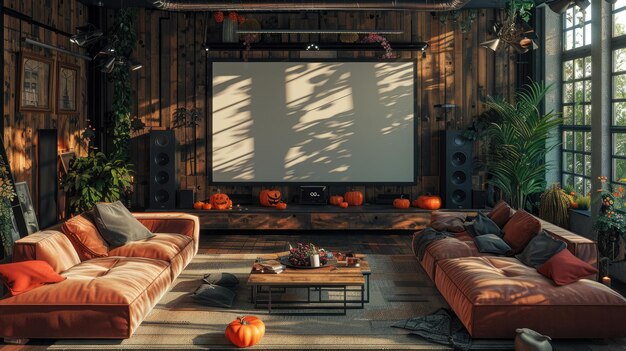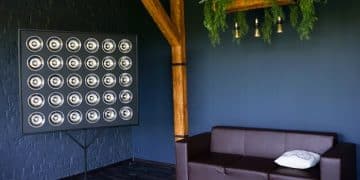Create a Home Theater on a Budget: DIY Movie Nights

Creating a home theater on a budget is an achievable DIY project that enhances your movie-watching experience with affordable solutions for screens, sound, and seating, transforming any room into a cozy cinema.
Ready to bring the thrill of the cinema into your home without breaking the bank? Creating a home theater on a budget: a DIY project for movie nights is easier than you think, offering affordable options for an immersive entertainment experience.
Transform Your Living Room: The DIY Home Theater Dream
Turning your living room into a home theater can be a rewarding DIY project. It’s about creating an immersive experience with the resources you have, focusing on the essentials without overspending.
A well-planned DIY home theater can offer a cinematic experience right in the comfort of your home. Let’s explore the essential elements to consider when embarking on this exciting project.
Planning Your Space
Before diving into equipment purchases, assess your space. Consider the room’s size, natural light, and acoustics to optimize your home theater setup.
Budget Allocation
Decide on a budget and allocate funds to different components like the screen, audio system, and seating. Prioritize items that will have the most impact on your viewing experience.
- Screen Size: Choose a screen size that fits comfortably within your viewing space.
- Seating Arrangement: Optimize seating for the best viewing angles.
- Soundproofing: Consider simple soundproofing methods to enhance audio quality.
Transforming your living room into a captivating home theater space requires careful planning and resource allocation. By thoughtfully addressing key factors such as room size, natural light management, and budget allocation, you can maximize the impact of your cinematic setup.

Projector vs. TV: Affordable Display Options
The centerpiece of any home theater is the display. You’ll need to decide between a projector and a TV, each offering unique pros and cons when building a home theater on a budget: a DIY project for movie nights.
Projectors offer large screen sizes at a lower cost, while TVs provide better image quality and ease of use. Let’s explore these options in detail.
Projector Benefits
Projectors are ideal for those wanting a large screen experience without spending a fortune. They offer flexibility in screen size and can be easily stored when not in use.
TV Advantages
TVs offer superior image quality, especially in well-lit rooms. They are easy to set up and provide smart features for streaming content.
- Screen Size: Projectors can achieve larger screen sizes than TVs for the same price.
- Image Quality: TVs generally offer better image quality and brightness.
- Room Lighting: Consider room lighting when choosing between a projector and TV for optimal viewing.
Selecting the right display between a projector and a TV is a pivotal decision in crafting an affordable home theater experience. While projectors offer the allure of expansive screen sizes and enhanced flexibility, TVs present superior image quality and user-friendliness. By carefully weighing the advantages and drawbacks of each option, you can tailor your choice to meet the specific demands of your home setup.
Sound on a Shoestring: Budget-Friendly Audio Solutions
Audio is just as essential as visuals for an immersive movie experience when considering a home theater on a budget: a DIY project for movie nights. Fortunately, there are many budget-friendly options to enhance your sound quality.
Investing in a decent audio system can elevate your movie nights. Let’s explore affordable audio solutions for your DIY home theater.
Soundbar Solutions
Soundbars are an easy way to improve audio quality without the complexity of multi-speaker systems. They offer a sleek design and enhanced sound.
Used Audio Equipment
Consider purchasing used audio equipment for significant savings. Check online marketplaces and local classifieds for deals on speakers and receivers.
- Soundbar Placement: Position the soundbar for optimal sound projection.
- Speaker Configuration: Experiment with speaker placement to achieve the best surround sound effect.
- Volume Levels: Adjust volume levels for clear dialogue and immersive sound effects.
Achieving immersive audio on a budget is a pivotal aspect of creating an exceptional home theater when considering a home theater on a budget: a DIY project for movie nights. By exploring a diverse array of cost-effective audio solutions, such as energy-efficient soundbars and refurbished equipment, you can transform your space into a captivating cinematic environment.

Creating the Ambiance: Lighting and Decor on a Dime
Ambiance is critical to any successful home theater setup. The right lighting and decor can transform your viewing experience from good to great.
Creating a cozy and inviting atmosphere doesn’t have to be costly. Let’s explore affordable lighting and decor ideas for your DIY home theater.
DIY Lighting Solutions
Utilize dimmable LED lights to control the brightness and create a cinematic mood. String lights and lamps can also add warmth and ambiance.
Comfortable Seating Ideas
Repurpose existing furniture or invest in affordable bean bags or floor cushions for comfortable seating. Add throw pillows and blankets for extra coziness.
- Color Scheme: Choose a color scheme that complements your decor and enhances the movie-watching experience.
- Wall Decor: Add movie posters or themed decorations to personalize your space.
- Comfort Elements: Incorporate soft elements like rugs and curtains to improve acoustics and comfort.
Crafting the perfect ambiance through lighting and décor is essential to elevate your home theater experience. By embracing DIY lighting solutions, repurposing existing furniture, and strategically incorporating affordable accessories, you can transform your space into an oasis of visual delight and comfort.
DIY Screen Magic: Building Your Own Projection Screen
For projector enthusiasts, building your own screen can save money and provide a customized viewing experience. It’s a simple, yet effective way to personalize your DIY home theater.
Creating a DIY projection screen allows you to tailor the size and material to your specific needs. Let’s explore the steps to build your own screen.
Materials Needed
Gather essential building materials like fabric, wood, and hardware to construct the custom-built screen.
Assembly Steps
Follow simple assembly steps for the home theater screen, ensuring each component aligns seamlessly.
- Frame Construction: Build a sturdy frame using wood and secure it with screws or nails.
- Fabric Stretching: Stretch the fabric tightly over the frame, ensuring a smooth and wrinkle-free surface.
- Mounting Options: Mount the screen to the wall or create a freestanding setup for easy portability.
Building a custom-tailored projection screen can significantly enhance your home theater experience. By carefully selecting the size, materials, and assembly techniques, it ensures crystal-clear visuals and optimized display, allowing you to personalize every detail for an unmatched cinematic adventure.
Content is King: Streaming Services and Free Options
Once your home theater is set up, access to content is crucial. Explore streaming services and free options to keep the movies rolling.
From subscription-based platforms to free content sources, let’s explore the best options for accessing movies and shows.
Subscription Services
Explore popular streaming services like Netflix, Hulu, and Amazon Prime Video for a wide range of movies and TV shows. Choose services based on your viewing preferences.
Free Content Sources
Take advantage of free content sources like Pluto TV, Tubi, and local library rentals. These options can provide hours of entertainment without additional costs.
- Streaming Devices: Use streaming devices like Roku, Chromecast, or Apple TV for easy access to your favorite apps.
- Content Variety: Explore different streaming services to find the best content for your interests.
- Subscription Management: Manage your subscriptions wisely to avoid overspending on services you rarely use.
Gaining access to content is essential in completing your home theater setup. By exploring diverse streaming services like Netflix, Hulu, and Amazon Prime Video, as well as utilizing free options such as Pluto TV and Tubi, you can keep the movies rolling and fully enjoy your cinematic haven.
Maintenance and Upgrades: Keeping Your Theater Fresh
Maintaining your home theater and considering future upgrades can keep your setup current and enjoyable for years to come. Cleaning and updating your theater space will ensure it’s always at its best.
Regular maintenance and smart upgrades can prolong the life of your home theater. Let’s explore essential maintenance tips and potential upgrades.
Cleaning and Organization
Regularly clean your screen, speakers, and seating areas to prevent dust buildup and maintain optimal performance. Organize cables and accessories for a clutter-free environment.
Potential Upgrades
Consider upgrading components like the projector or sound system as your budget allows. These enhancements can significantly improve your viewing experience.
- Software Updates: Keep your streaming devices and smart TVs updated with the latest software for optimal performance.
- Equipment Calibration: Calibrate your projector and audio system periodically to ensure accurate color and sound reproduction.
- Acoustic Enhancements: Add acoustic panels or sound dampening materials to improve sound quality.
Effective maintenance and well-planned upgrades are essential to keep your home theater fresh and enjoyable. Regularly cleaning your screen and speakers, organizing cables, and considering future improvements can preserve the longevity of your theater space!
| Key Point | Brief Description |
|---|---|
| 🎬 Display Choice | Projector for size, TV for quality. |
| 🔊 Audio Options | Soundbars or used equipment save money. |
| 💡 Ambiance | Dimmable lights and comfy seating enhance the experience. |
| 🛠️ Screen Build | DIY screen saves costs and personalizes size. |
FAQ
▼
Look for LCD projectors as they tend to be more affordable. Check for models with decent resolution (at least 720p) and brightness suitable for your room.
▼
Start with a basic soundbar. Position it correctly beneath your screen for clear sound. Consider adding a used subwoofer later for enhanced bass.
▼
Measure the distance from your seating area to the wall. A good rule of thumb is to divide that distance by 1.5 to find the ideal screen diagonal in inches.
▼
Use cable ties or sleeves to bundle and hide cables. Consider running cables through walls or using cable concealers for a cleaner look.
▼
Netflix and Amazon Prime Video have extensive movie libraries. Consider a rotating subscription to different services each month to maximize content without overspending.
Conclusion
Creating a home theater on a budget: a DIY project for movie nights doesn’t require a fortune. By making smart choices about your display, sound, lighting, and content sources, you can bring the magic of the movies into your home without breaking the bank. Get creative, have fun, and enjoy your personalized cinematic experience!





